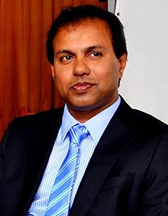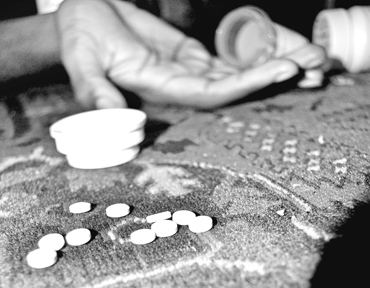Addicted!
With an estimated 100,000 addicts, drug abuse is a
serious problem, but cause for concern is the toxic cocktail that’s
being used to retain the high:
by Carol Aloysius
|

Dr. Chamira Nilanga Samarasingha |
Living in violent households where at least one parent uses narcotics
or abuses alcohol, many young adults today are increasingly at risk of
becoming victims of substance abuse themselves. And many adolescents are
indeed experimenting with various forms of drugs, which they inhale or
inject into their bodies. Of this group, more than a few are likely to
end up as addicts, while the rest are more likely to put such
experiments behind them as they mature.
Yet the tragic fact is that all of them will suffer from negative
health impacts. For even a small amount of these harmful drugs, which
are often a cocktail of other harmful drugs, is likely to take a toll on
their health.
A drug addict can be anybody, for drug addiction is non
discriminatory. Although 98% of drug addicts in Sri Lanka are males,
women are also being drawn into this habit, many of them being sex
workers who have been forced into taking drugs by their male partners
who are often involved in the peddling drugs. Increasing these women are
used to sell drugs to young drug addicts.
Chairman of the National Drugs Control Board, Dr Nalinga Samarasinghe,
in this interview with the Sunday Observer, answers a wide range of
questions about drug abuse, its health impacts, sexually transmitted
diseases and say though Sri Lanka with 2.5% drug addicts rank below the
global average of 5%, the actual official and unofficial numbers show a
huge disparity, with the estimated number being 50,000 and the more
likely figure being in the range of 100,000, although he admits no head
count has been taken to verify the latter figure. Pointing out that
official figures are based on statistics sent from hospitals and clinics
which drug addicts have visited for various reasons, he explains only a
few addicts will actually admit to taking drugs and that neither they or
their parents or guardians are willing to voluntarily give out this
information .”So what we are left is estimated statistics.”
Excerpts:
Q: How did you come up with the 100,000 figure?
A: Step out into the streets and see for yourself the number
of drug addicts roaming the streets, especially in urban areas such as
Colombo, Galle, Gampaha and Kandy. You will see them sleeping on
pavements and bus stops.
Or pass them while they hide themselves in alleys and dark corners so
that they can’t be seen as they inject themselves or inhale drugs.
The numbers are many but my guess is it could be over a 100.000, as
this vicious trend is gradually infiltrating our rural villages.
If it is not controlled or stopped, it can destroy the youth of our
country.
Q: So how bad is the situation?
A: Although the prevalence rate is high, the actual level of
consumption of pure drugs is low. This is because what they are actually
taking is really a mix of a lot of other drugs, which though harmful to
health, may not affect their brains as much as taking pure drugs.
|

Pic: en.wikipedia.org |
Q: What other drugs?
A: They range from lactose to powdered diazepam, panadol and
aspirin to kurakkan flour and crushed mosquito coil.
They give the effect of heroin or marijuana or some other drugs
consumed here, but don’t have the same impact that pure drugs have. What
is more dangerous is that drug traders double the amount of these
extraneous agents just to make an extra buck.
So a 100 gram of heroin bought from a street vendor would actually
consist of an additional 100 grams of a ‘drug cocktail.
Health Impact
Q: What are the health impacts of drug addiction?
A: They are wide ranging and have increased due to the
proliferation of new and more dangerous narcotics appearing on the scene
in recent years.
Q: Elaborate.
A: Some of the major problems arising from inhaling of drugs
relate to chest and respiratory diseases. Their lungs get weak .They
become prone to Tuberculosis (TB).
Q: How?
A. TB has a six month regime, which patients are required to
complete in order to be cured.
In the case of drug addicts, many of them don’t complete this course
and go back to the streets only half cured. This can cause Multi Drug
Resistance TB (MDR TB), for which there is no medication.
Q: How can one recognise the onset of this disease?
A: The symptoms are similar to TB such as persistent coughing,
blood in sputum, weight loss, sweating at night, fever.
Q. Chasing the dragon is another form of inhaling drugs. Why
is it called that?
A: When heroin is burned it forms a thick smoke, which has a
typical shape of a Chinese dragon. Addicts who use this method, usually
inhale the smoke through a drinking straw.
Q: What is the health implication?
A: If the patient has TB or HIV, it worsens his condition.
Q: Can they infect others?
A: Yes. If you are travelling in a bus or train be careful of
the person you sit next to.
He could infect you and the rest in the bus or train compartment he
is travelling in, just by coughing and releasing the infected droplets
into the air. Always cover your nose with a handkerchief, if someone
seated close to you is coughing.
STD
Q: How is STD linked to drug addiction?
|
Roads most
dangerous
According to Police Narcotics Bureau
sources, some of the most notable areas in Colombo where the
prevalence rate is the highest and where such illegal deals
are struck and the products thereafter distributed by street
dealers, are Magazine Road, Serpentine Road, Grandpass,
Dematagoda, and Kunuela in Wattala.
Dr Samarasinghe says the drug dealers are
now increasingly using their women folk, usually their
wives, to lure more addicts to the business. “However we
have not found any evidence of children being used for this
business as most men, although willing to exploit their
wives to do their dirty business, will hesitate using their
children as they have told us they don’t want their children
to become drug addicts,” he says. |
A: Most drug addicts are not concerned about personal hygiene.
They also have many sexual partners who could carry STDs that could
infect them if they aren’t infected already. They also use injectable
utensils like syringes, cotton swabs and heat blood in test tubes,
mixing it with lemon juice to prevent clotting. Because they share these
utensils with others, they have a high chance of getting Hepatitis C and
HIV as well as other blood borne diseases. Hepatitis C is a blood borne
disease, which is incurable and spreads rapidly. It affects the liver
and one can also get hepatic cancer.”
Treatment
Q. What is the usual treatment given to a drug addict? Are
there special rehabilitation and treatment centres for them?
A: There are five rehabilitation treatment centres run by the
State, and between 20 and 30 run by non-governmental orgainsations. Most
of the time we use non drug treatment methods or modules such as
counselling, faith based treatment, community based modules.
Q: Elaborate.
A: Faith based modules involve prayer and meditation. The
community based module involves allowing an addict who has been
rehabilitated but gone back to his old habit to tell his story while
others in the same group share their own experiences on the same theme.
Q: Any other treatment procedures?
A: We also use a narcotics substitute treatment method, where
we offer patients alternative drugs with less impacts. But the danger is
they could become addicted to this substitute.
Q: How can this gap be filled?
A: Persons with drug problems need to have regular programme
which they will follow through. They need more trained counsellors whom
they can trust. We also need volunteers from the community to prevent
these kids from going back to the streets once they are discharged from
the Rehab centres.
We also need to have more life skill programmes to empower them with
vocational skills. Once discharged from the rehab centres, they also
need to get a regular employment to keep them off drugs.
For all this the mindset of the people must change.
Q: Any plans for the future?
A: We hope to use social media to get our message across to
young people who are vulnerable to drug addiction. Using TV, e-mail,
twitter to give short messages and cartoons on drugs, and street dramas
will appeal to the target group more than lectures and discussions,
which bore them. We have set up a Volunteer forum to help us.
Q:Your message to the public?
A: 2020 has been set as the deadline for Sri Lanka to reach
its goal of a Drugs Free nation. For this to become a reality, we need
the co-operation of everyone – from school heads to office managers to
corporate heads to politicians and the clergy. |

